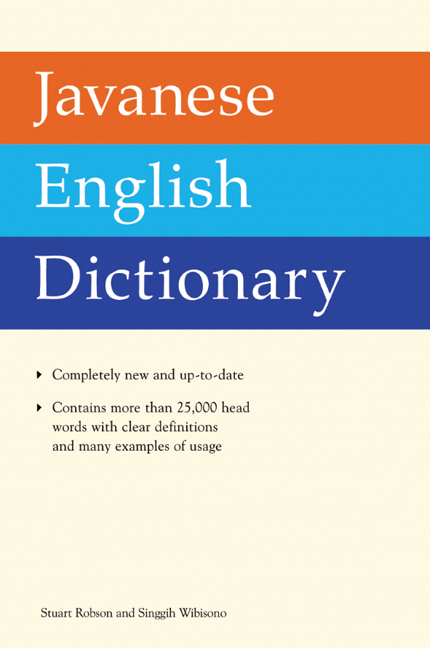 With at least 85 million speakers, Javanese is by far the largest of Indonesia's
minority languages.
SEAlang's Javanese dictionary is based on
Javanese-English Dictionary, by Stuart Robson
and Singgih Wibisono; published in 2002 by
Periplus Editions (HK),
and used with their permission.*
With at least 85 million speakers, Javanese is by far the largest of Indonesia's
minority languages.
SEAlang's Javanese dictionary is based on
Javanese-English Dictionary, by Stuart Robson
and Singgih Wibisono; published in 2002 by
Periplus Editions (HK),
and used with their permission.*
Despite Robson's introductory comment that he only "scratches the surface" of Javanese,
Robson2002 is the definitive reference.
The work has roughly 30,000 heads, 15,000 subentries, and 2,500 phrasal examples;
it extensively marks register distinctions, literary and dialectal forms, and other
features of interest.
Robson's work on Modern Javanese complements his efforts (with P.J. Zoetmulder)
on the Old Javanese-English Dictionary (1982, KITLV), a massive
dictionary and corpus of pre-modern literature and inscriptions.
Display Please note the alternatives for display on the left (try with "anak"):
--
show self only shows the headword or derived form that matched.
--
show self/parent shows the lemma of the (derived) form as well.
--
show family shows the lemma and all derived forms.
Searching Searches may:
--
match a single character with ?, and zero or more
with *. Thus, ca?an matches caann, while ca*an matches
cabang, cacacan, cakupan, and many others.
--
require matches for both, or either, Indonesian text (of the headword),
or English text (in the definition).
--
be limited to a particular etymology, usage, type, or subject.
--
search examples for an instance of the word if it isn't found in a head (try mobil).
--
next, lemmatize the word, and search for the root.
--
In case of a multi-word phrase, we automatically search examples, then search
for the phrase as a list of separate words, then search for the list of roots.
Copyright notice
* Copyright 2002 Periplus Editions (HK). Text taken from the Javanese-English dictionary is used by permission of the publisher, and may not be reproduced without permission.